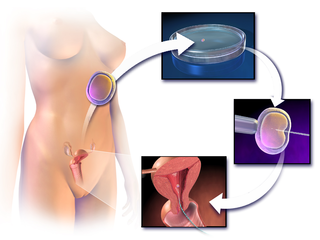
In vitro fertilisation (IVF) is a process of fertilisation where an egg is combined with sperm in vitro. The process involves monitoring and stimulating a woman's ovulatory process, removing an ovum or ova from her ovaries and letting sperm fertilise them in a culture medium in a laboratory. After the fertilised egg (zygote) undergoes embryo culture for 2–6 days, it is transferred by catheter into the uterus, with the intention of establishing a successful pregnancy.

An image is a visual representation of something. An image can be a two-dimensional (2D) representation, such as a drawing, painting, or photograph, or a three-dimensional (3D) object, such as a carving or sculpture. An image may be displayed through other media, including projection on a surface, activation of electronic signals, or digital displays. Two-dimensional images can be still or animated. Still images can usually be reproduced through mechanical means, such as photography, printmaking or photocopying. In some cases, three-dimensional images may also be animated.
Reproductive technology encompasses all current and anticipated uses of technology in human and animal reproduction, including assisted reproductive technology, contraception and others. It is also termed Assisted Reproductive Technology, where it entails an array of appliances and procedures that enable the realization of safe, improved and healthier reproduction. While this is not true of all people, for an array of married couples, the ability to have children is vital. But through the technology, infertile couples have been provided with options that would allow them to conceive children.

Intracytoplasmic sperm injection is an in vitro fertilization (IVF) procedure in which a single sperm cell is injected directly into the cytoplasm of an egg. This technique is used in order to prepare the gametes for the obtention of embryos that may be transferred to a maternal uterus. With this method, the acrosome reaction is skipped.

Assisted reproductive technology (ART) includes medical procedures used primarily to address infertility. This subject involves procedures such as in vitro fertilization (IVF), intracytoplasmic sperm injection (ICSI), cryopreservation of gametes or embryos, and/or the use of fertility medication. When used to address infertility, ART may also be referred to as fertility treatment. ART mainly belongs to the field of reproductive endocrinology and infertility. Some forms of ART may be used with regard to fertile couples for genetic purpose. ART may also be used in surrogacy arrangements, although not all surrogacy arrangements involve ART. The existence of sterility will not always require ART to be the first option to consider, as there are occasions when its cause is a mild disorder that can be solved with more conventional treatments or with behaviors based on promoting health and reproductive habits.

Surrogacy is an arrangement, often supported by a legal agreement, whereby a woman agrees to delivery/labour on behalf of another couple or person, who will become the child's parent(s) after birth. People may seek a surrogacy arrangement when a couple do not wish to carry a pregnancy themselves, when pregnancy is medically impossible, when pregnancy risks are dangerous for the intended mother, or when a single man or woman or a same sex couple wish to have a child.
The Journal of the Association for Information Science and Technology is a monthly peer-reviewed academic journal covering all aspects of information science published by Wiley-Blackwell on behalf of the Association for Information Science and Technology. The journal publishes original research and rapid communications, as well as book reviews and announcements of the association. Occasional special issues appear with contents focused on a single topic area.

The European Society of Human Reproduction and Embryology (ESHRE) was founded in 1985 by Robert Edwards and J. Cohen (Paris), who felt that the study and research in the field of reproduction needed to be encouraged and recognized. It is currently headquartered in Belgium.

The American Society for Reproductive Medicine (ASRM) is a nonprofit, multidisciplinary organization for advancement of the science and practice of reproductive medicine. The society has its headquarters in Washington, D.C and its administrative office in Birmingham, Alabama.
Biocybernetics is the application of cybernetics to biological science disciplines such as neurology and multicellular systems. Biocybernetics plays a major role in systems biology, seeking to integrate different levels of information to understand how biological systems function. The field of cybernetics itself has origins in biological disciplines such as neurophysiology. Biocybernetics is an abstract science and is a fundamental part of theoretical biology, based upon the principles of systemics. Biocybernetics is a psychological study that aims to understand how the human body functions as a biological system and performs complex mental functions like thought processing, motion, and maintaining homeostasis.(PsychologyDictionary.org)Within this field, many distinct qualities allow for different distinctions within the cybernetic groups such as humans and insects such as beehives and ants. Humans work together but they also have individual thoughts that allow them to act on their own, while worker bees follow the commands of the queen bee. . Although humans often work together, they can also separate from the group and think for themselves.(Gackenbach, J. 2007) A unique example of this within the human sector of biocybernetics would be in society during the colonization period, when Great Britain established their colonies in North America and Australia. Many of the traits and qualities of the mother country were inherited by the colonies, as well as niche qualities that were unique to them based on their areas like language and personality—similar vines and grasses, where the parent plant produces offshoots, spreading from the core. Once the shoots grow their roots and get separated from the mother plant, they will survive independently and be considered their plant. Society is more closely related to plants than to animals since, like plants, there is no distinct separation between parent and offspring. The branching of society is more similar to plant reproduction than to animal reproduction. Humans are a k- selected species that typically have fewer offspring that they nurture for longer periods than r -selected species. It could be argued that when Britain created colonies in regions like North America and Australia, these colonies, once they became independent, should be seen as offspring of British society. Like all children, the colonies inherited many characteristics, such as language, customs and technologies, from their parents, but still developed their own personality. This form of reproduction is most similar to the type of vegetative reproduction used by many plants, such as vines and grasses, where the parent plant produces offshoots, spreading ever further from the core. When such a shoot, once it has produced its own roots, gets separated from the mother plant, it will survive independently and define a new plant. Thus, the growth of society is more like that of plants than like that of the higher animals that we are most familiar with, there is not a clear distinction between a parent and its offspring. Superorganisms are also capable of the so-called "distributed intelligence," a system composed of individual agents with limited intelligence and information. These can pool resources to complete goals beyond the individuals' reach on their own. Similar to the concept of "Game theory." In this concept, individuals and organisms make choices based on the behaviors of the other player to deem the most profitable outcome for them as an individual rather than a group.

Postgenderism is a social, political and cultural movement which arose from the eroding of the cultural, psychological, and social role of gender, and an argument for why the erosion of binary gender will be liberatory.

Human reproduction is sexual reproduction that results in human fertilization to produce a human offspring. It typically involves sexual intercourse between a sexually mature human male and female. During sexual intercourse, the interaction between the male and female reproductive systems results in fertilization of the ovum by the sperm to form a zygote. These specialized reproductive cells are called gametes, which are created in a process called gametogenesis. While normal cells contain 46 chromosomes, gamete cells only contain 23 single chromosomes, and it is when these two cells merge into one zygote cell that genetic recombination occurs and the new zygote contains 23 chromosomes from each parent, giving it 46 chromosomes. The zygote then undergoes a defined development process that is known as human embryogenesis, and this starts the typical 9-month gestation period that is followed by childbirth. The fertilization of the ovum may be achieved by artificial insemination methods, which do not involve sexual intercourse. Assisted reproductive technology also exists.
Ann A. Kiessling is an American reproductive biologist and a researcher in human parthenogenic stem cell research at The Bedford Research Foundation. She was an associate professor in teaching hospitals of Harvard Medical School from 1985 until 2012.
Reproductive endocrinology and infertility (REI) is a surgical subspecialty of obstetrics and gynecology that trains physicians in reproductive medicine addressing hormonal functioning as it pertains to reproduction as well as the issue of infertility. While most REI specialists primarily focus on the treatment of infertility, reproductive endocrinologists are trained to also test and treat hormonal dysfunctions in females and males outside infertility. Reproductive endocrinologists have specialty training (residency) in obstetrics and gynecology (ob-gyn) before they undergo sub-specialty training (fellowship) in REI.
Reproduction is a monthly peer-reviewed medical journal covering the cellular and molecular biology of reproduction, including the development of gametes and early embryos in all species; developmental processes such as cell differentiation, morphogenesis and related regulatory mechanisms in normal and disease models, assisted reproductive technologies in model systems and in a clinical environment, and reproductive endocrinology, immunology and physiology. Emerging topics including cloning, the biology of embryonic stem cells, environmental effects on reproductive potential and health, and epigenetic effects on reproductive and developmental processes are also covered. All editorial and review content is free to access from publication; research articles become available after 12 months.
Reproduction, Fertility and Development is an international peer-reviewed scientific journal published by CSIRO Publishing. The journal publishes original and significant contributions on vertebrate reproductive and developmental biology. Subject areas include, but are not limited to: physiology, biochemistry, cell and molecular biology, endocrinology, genetics and epigenetics, behaviour, immunology and the development of reproductive technologies in humans, livestock and wildlife, and in pest management.

Human Reproduction is a peer-reviewed scientific journal covering all aspects of human reproduction, including reproductive physiology and pathology, endocrinology, andrology, gonad function, gametogenesis, fertilization, embryo development, implantation, pregnancy, genetics, preimplantation genetic diagnosis, oncology, infectious disease, surgery, contraception, infertility treatment, psychology, ethics, and social issues. It is an official journal of the European Society of Human Reproduction and Embryology. It was established in 1986 with Robert Edwards as founding editor-in-chief.
GEOBASE is a database, multidisciplinary in scope, which indexes bibliographic information and abstracts for the Geographical, Earth, and Ecological sciences, published by Engineering Information, a subsidiary of Elsevier. The broad subject coverage includes earth sciences, ecology, geomechanics, human geography, physical geography, social geography and oceanography. Development studies are also included in this database.

Folliculogenesis-specific basic helix-loop-helix, also known as factor in the germline alpha (FIGalpha) or transcription factor FIGa, is a protein that in humans is encoded by the FIGLA gene. The FIGLA gene is a germ cell-specific transcription factor preferentially expressed in oocytes that can be found on human chromosome 2p13.3.
The Royal Commission on New Reproductive Technologies, often referred to as the "Baird Commission", was created by the Canadian federal government under Brian Mulroney in 1989 to study the ethical, social, research, and legal implications of new reproductive technologies in Canada. The Canadian government, along with many other citizens, had grown increasingly concerned about the impact of in vitro fertilization and other rapidly progressing technologies. The commission was chaired by Patricia Baird. It published its final report in 1993, which was presented to the Canadian Governor General. The report later served the basis for the federal statute, the Assisted Human Reproduction Act.










